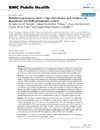Identificador persistente para citar o vincular este elemento:
https://accedacris.ulpgc.es/jspui/handle/10553/9026
| Título: | Relationship between body image disturbance and incidence of depression: the SUN prospective cohort | Autores/as: | Marçal Pimenta, Adriano Sánchez-Villegas, Almudena Bes-Rastrollo, Maira López, Celeste Nicole Martínez-González, Miguel Ángel |
Clasificación UNESCO: | 32 Ciencias médicas 61 Psicología |
Palabras clave: | Binge-Eating Disorder Dysmorphic Disorder Anorexia-Nervosa Major Depression Self-Discrepancy, et al. |
Fecha de publicación: | 2009 | Proyectos: | Red Alimentación Saludable en la Prevención Primaria de Enfermedades Crónicas: la Red Predimed. (Retics 2006) | Publicación seriada: | BMC Public Health | Resumen: | Background: Body image disturbance is an increasing problem in Western societies and is associated with a number of mental health outcomes including anorexia, bulimia, body dysmorphia, and depression. The aim of this study was to assess the association between body image disturbance and the incidence of depression. Methods: This study included 10,286 participants from a dynamic prospective cohort of Spanish university graduates, who were followed-up for a median period of 4.2 years (Seguimiento Universidad de Navarra – the SUN study). The key characteristic of the study is the permanently open recruitment that started in 1999. The baseline questionnaire included information about body mass index (BMI) and the nine figure schemes that were used to assess body size perception. These variables were grouped according to recommended classifications and the difference between BMI and body size perception was considered as a proxy of body image disturbance. A subject was classified as an incident case of depression if he/she was initially free of depression and reported a physician-made diagnosis of depression and/or the use of antidepressant medication in at least one of the follow-up questionnaires. The association between body image disturbance and the incidence of depression was estimated by calculating the multivariable adjusted Odds Ratio (OR) and its 95% Confidence Interval (95% CI), using logistic regression models. Results: The cumulative incidence of depression during follow-up in the cohort was 4.8%. Men who underestimated their body size had a high percentage of overweight and obesity (50.1% and 12.6%, respectively), whereas women who overestimated their body size had a high percentage of underweight (87.6%). The underestimation exhibited a negative association with the incidence of depression among women (OR: 0.72, 95% CI: 0.54 – 0.95), but this effect disappeared after adjusting for possible confounding variables. The proportion of participants who correctly perceived their body size was high (53.3%) and gross misperception was seldom found, with most cases selecting only one silhouette below (42.7%) or above (2.6%) their actual BMI. Conclusion: We found no association between body image disturbance and subsequent depression in a cohort of university graduates in Spain. | URI: | https://accedacris.ulpgc.es/handle/10553/9026 | Otros identificadores: | http://dx.doi.org/10.1186/1471-2458-9-1 | DOI: | 10.1186/1471-2458-9-1 | Fuente: | BMC Public Health 2009, 9:1 |
| Colección: | Artículos |
Citas SCOPUSTM
39
actualizado el 08-jun-2025
Citas de WEB OF SCIENCETM
Citations
33
actualizado el 08-jun-2025
Visitas
69
actualizado el 16-sep-2023
Descargas
98
actualizado el 16-sep-2023
Google ScholarTM
Verifica
Altmetric
Comparte
Exporta metadatos
Los elementos en ULPGC accedaCRIS están protegidos por derechos de autor con todos los derechos reservados, a menos que se indique lo contrario.
